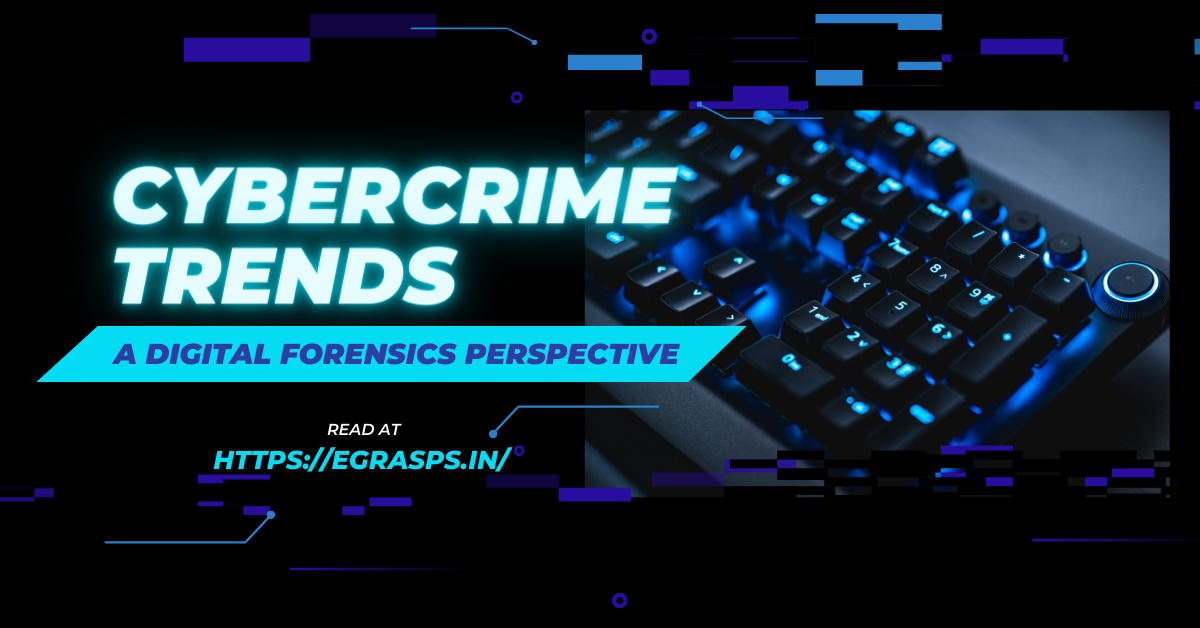In today’s linked world, cybercrime has become a worrisome trend that endangers individuals, organizations, and governments. As cybercriminals’ strategies evolve, digital forensics becomes increasingly important in identifying, analyzing, and mitigating such threats. In this blog article, we will look at some of today’s cybercrime trends and how digital forensics professionals can help address them.

The Shifting Landscape of Cybercrime
Cybercrime is an ever-changing world, with threat actors getting more sophisticated in their tactics. One notable trend is the surge in ransomware assaults. These harmful tactics encrypt a victim’s data and then demand a ransom for its release. Digital forensics professionals play an important role in responding to such incidents by using specialized tools and procedures to determine the source of the attack, identify the perpetrators, and retrieve damaged data.
Another noticeable development is the increase in phishing attempts, in which fraudsters use fraudulent emails or websites to deceive people into disclosing important information. Digital forensics aids in assessing phishing efforts, locating culprits, and establishing prevention tactics for future attacks.
Digital Forensics in Ransomware Investigations
Ransomware attacks have become more common and sophisticated, affecting individuals, organizations, and even vital infrastructure. Digital forensics experts are at the forefront of these investigations. Their skill is critical in recognizing the ransomware version, evaluating its behavior, and locating the harmful code’s entrance point.
Forensic technologies allow investigators to track cryptocurrency transactions, which are frequently the preferred means of ransom payment for cybercriminals. By studying blockchain records, digital forensics professionals can track the money path, potentially leading to the arrest of the perpetrators.
Furthermore, these professionals are working on developing decryption tools to help people recover their encrypted data without submitting to ransom requests. Collaboration between digital forensics professionals and law enforcement organizations is critical for bringing hackers to justice.
Addressing the Surge in Phishing Attacks
Phishing attacks are still a popular and successful way for cybercriminals to corrupt individuals and organizations. Digital forensics is useful in understanding the complexity of phishing attempts. When a phishing assault takes place, forensic analysts investigate the phishing emails, malicious websites, and compromised systems to determine the attack vector.
Digital forensics professionals can track out the source of the phishing assault by studying the digital artifacts left behind, such as email headers, IP addresses, and malware signatures. This information is extremely useful for both incident reaction and prevention efforts.
Furthermore, digital forensics is critical in educating individuals and companies about current phishing strategies. Understanding fraudsters’ strategies can help users spot and prevent phishing scams.
The Role of Digital Forensics in Incident Response
In the face of constantly evolving cyber threats, incident response teams rely largely on digital forensics to analyze and contain security problems. The timeline of an incident, from the first compromise to the detection and containment phases, is precisely recreated using digital forensics analysis.
Digital forensics professionals use a number of tools and strategies to collect evidence, analyze malware, and comprehend attacker tactics, techniques, and procedures (TTPs). This information is critical for creating effective incident response plans and strengthening cybersecurity defenses.
Challenges and Future Considerations
While digital forensics has proven to be an effective tool for preventing cybercrime, problems remain. Investigators face considerable challenges as hackers increasingly utilize encryption to mask their actions. While encryption is necessary for data and communication security, it can impede forensic analysis.
Furthermore, the rapid development of technologies like artificial intelligence (AI) and the Internet of Things (IoT) creates new obstacles for digital forensics. Investigating incidents utilizing AI-generated content or corrupted IoT devices necessitates adaptability and creativity in forensic methods.
As cyber dangers evolve, the function of digital forensics will become increasingly important. Continuous education, collaboration between industry and law enforcement, and the development of improved forensic tools are critical to staying ahead of hackers.
Conclusion
In the ever-changing cybercrime scene, digital forensics is a critical line of protection. By evaluating and comprehending current cybercrime patterns, digital forensics specialists may create effective investigation, response, and prevention plans. As technology advances, digital forensics will continue to play an important role in combatting cyber threats, guaranteeing a safer digital environment for both individuals and enterprises.
Reach out to us for training on Cyber Security for your organization/employees.
We hope that we bring some value to your life by posting our content, which might meet your expectations. You can always comment on the post to give feedback or reach out to us through email to share what you like to read on our blog.
Reach out to us using email: [email protected]
Open Demat Account with Upstox | Zerodha
Find More Articles on Our Website: EGrasps
You can reach out to us on WhatsApp.
Disclaimer:
- All the information provided by us “EGrasps.in” are for educational purposes only.
- Display of any trademarks, tradenames, logos, and other subject matters of Intellectual Property (IP) belongs to their respective Intellectual Property (IP) owners. Display of such IP along with the related product information does not imply EGrasps.in‘s partnership with the owner of the Intellectual Property or issuer/manufacturer of such products.



